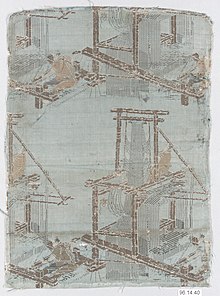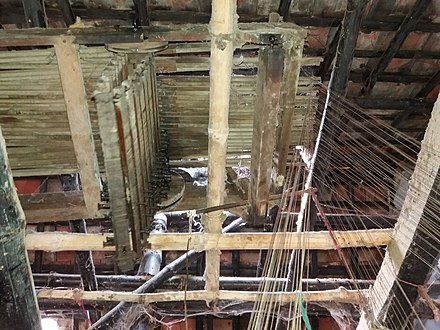Loom
[1][2][failed verification] By 1838 "loom" had gained the additional meaning of a machine for interlacing thread.Beams may be used as rollers to allow the weaver to weave a piece of cloth longer than the loom.Heddle-rods and shedding-sticks are not the fastest way to weave, but they are very simple to make, needing only sticks and yarn.So when the heddle rod is pulled out and placed in the forked sticks protruding from the posts (not lettered, no technical term given in citation), the shed (1) is replaced by the counter-shed (2).The combination of a heddle-bar and a shedding-stick can create the shed and countershed needed for a plain tabby weave, as in the video.The warp threads pass through the holes, and the cards are twisted and shifted to created varied sheds.There are heddles made of flip-flopping rotating hooks, which raise and lower the warp, creating sheds.They are mostly controlled by treadles; creating the shed with the feet leaves the hands free to ply the shuttle.[14][16] If the threads are rough, closely-spaced, very long or numerous, it can be hard to open the sheds on the jack loom.In a drawloom, a "figure harness" is used to control each warp thread separately,[20] allowing very complex patterns.A drawloom requires two operators, the weaver, and an assistant called a "drawboy" to manage the figure harness.[21] Some scholars speculate an independent invention in ancient Syria, since drawloom fabrics found in Dura-Europas are thought to date before 256 AD.Mechanical dobbies pull on the draw threads using pegs in bars to lift a set of levers.It is based on earlier inventions by the Frenchmen Basile Bouchon (1725), Jean Baptiste Falcon (1728), and Jacques Vaucanson (1740).With a flick of the wrist, one cord was pulled and the shuttle was propelled through the shed to the other end with considerable force, speed and efficiency.The whole picking motion no longer relied on manual skill and it was just a matter of time before it could be powered by something other than a human.Many advances in weft insertion have been made in order to make manufactured cloth more cost effective.Patented in 1802, dandy looms automatically rolled up the finished cloth, keeping the fell always the same length.They can readily produce warp-faced textiles, often decorated with intricate pick-up patterns woven in complementary and supplementary warp techniques, and brocading.When a weaver has woven far enough down, the completed section (fell) can be rolled around the top beam, and additional lengths of warp threads can be unwound from the weights to continue.The earliest evidence of a horizontal loom is found on a pottery dish in ancient Egypt, dated to 4400 BC.A treadle loom for figured weaving may have a large number of harnesses or a control head.Looms used for weaving traditional tapestry are called not as "vertical-warp" and "horizontal-warp", but as "high-warp" or "low-warp" (the French terms haute-lisse and basse-lisse are also used in English).They are made to fit under the fabric being mended, and are often held in place by an elastic band on one side of the cloth and a groove around the loom's darning-egg portion on the other.[52] Darning looms were sold during World War Two clothing rationing in the United Kingdom[53] and Canada,[54] and some are homemade.The capabilities of power looms gradually expanded, but handlooms remained the most cost-effective way to make some types of textiles for most of the 1800s.Edmund Cartwright built and patented a power loom in 1785, and it was this that was adopted by the nascent cotton industry in England.The invention of the flying shuttle by John Kay allowed a hand weaver to weave broadwoven cloth without an assistant, and was also critical to the development of a commercially successful power loom.[58] Cartwright's loom was impractical but the ideas behind it were developed by numerous inventors in the Manchester area of England.This symbolism is encapsulated in the classical myth of Arachne who was changed into a spider by the goddess Athena, who was jealous of her skill at the godlike craft of weaving.






















Loom (disambiguation)Knitting machineHattersley & SonsKeighleyflying shuttleautomatically rolls up the woven clothtapestrytensionOld EnglishWeavingTextile manufacturing terminologypawl and ratchetTurkeyProto-Indo-Europeanweaving museumLeidenshuttletabby weavePin weavingShed (weaving)Pin loomspeg loomsPile carpetstwill weavessatin weavesdiaper weavesbrocadesknotted-pile carpetwarp-weighted loomrebozoSanta María del Río, San Luis Potosítablet weavingDarning loominkle loomheddlestabby-weavebogolantreadlescombinationsto the power ofelastomercombinatorialState of ChuDura-Europasmusic boxdobby loomsolenoidsJacquard loomJoseph Marie Jacquardbrocadedamaskmatelassepunched cardsBasile BouchonJacques Vaucansoncomputer punched card readersVaranasiUttar PradeshŁódźPolandwarp-weighted loomscannonbonesnettingRhode IslandKhotanEstoniaNarrow clothcornelwoodtanmonoa cloth as wide as their armspanJohn KayIndustrial RevolutionPicanolweft insertionsair-jet loomRapier loomBeater (weaving)Coast SalishReed beaterRigid heddlesdandy loomdandy loomstemple (weaving)loom weightsselvagesstenter pinsAndean textilesnarrowclothwarp-facedsupplementary warpBalanced weavesT'bolit'nalakabacádying the warpHainan IslandPeople's Republic of Chinainkle weavingheddleTabletsNeolithicbroadwoven clothMiddle KingdomQashqaiBattenancient EgyptJacquard machinehaute-lisseBobbinsNiewe Kerk Middelburgknitting spoolcircular knittingPower loomQueen Street MillBurnleyMueller Cloth MillEuskirchenEdmund CartwrightHorrocks loomRoberts LoomtempleBulloughLancashire Loomput outNorthrop LoomDraper Corporation